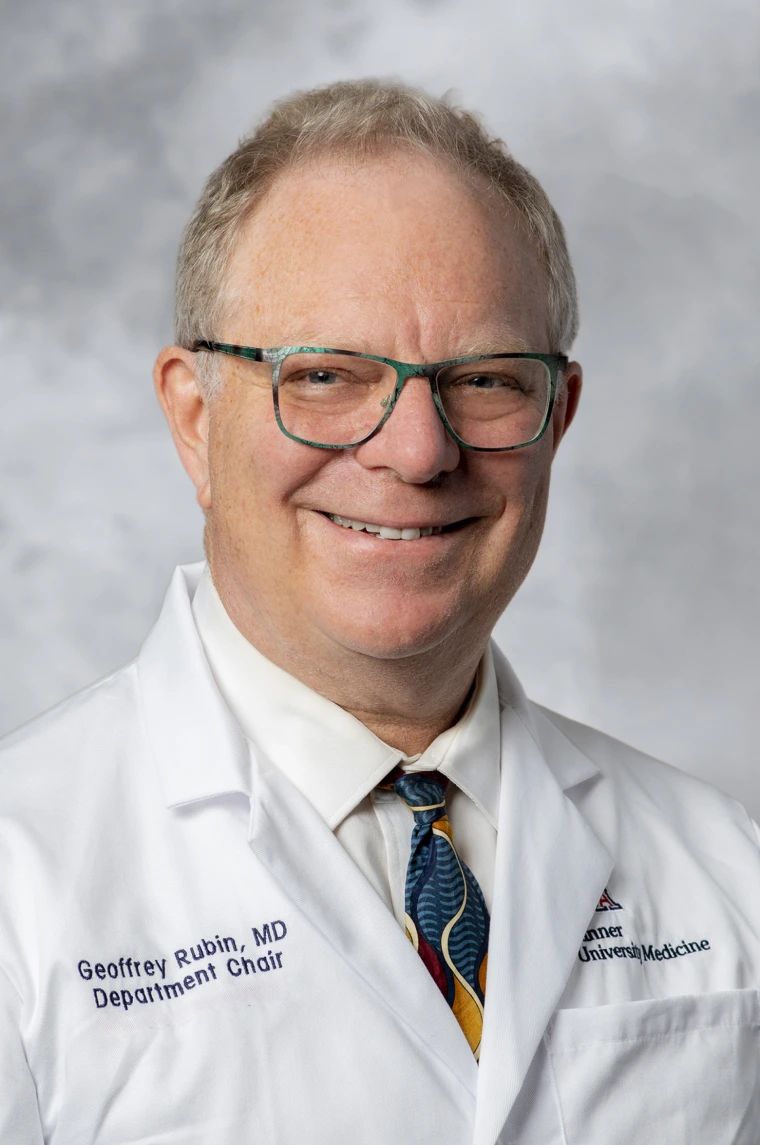Geoffrey Rubin, MD, MBA, FACR, FAAR, FAHA, FSABI, FNASCI

A renowned expert in the field of cardiovascular and pulmonary imaging, Dr. Rubin is originally from Los Angeles. Prior to joining the College of Medicine – Tucson, he spent more than two decades at Stanford University, earning the rank of full professor with university tenure in 2005, subsequently serving as chair of the Department of Radiology at the Duke University School of Medicine and the George B. Geller Distinguished Professor of Research in Cardiovascular Diseases. He also held a dual appointment in Duke’s Pratt School of Engineering as a professor of biomedical engineering.
Dr. Rubin has a rich history of medical contributions. Beginning in 1991, Dr. Rubin and colleagues at Stanford pioneered the development and use of spiral and multidetector-row CT for imaging the cardiovascular system. He is the lead author on the earliest scientific reports of CT angiography applied to a breadth of thoracic, abdominal and peripheral vascular applications.
Dr. Rubin co-founded the Stanford 3-D Medical Imaging Laboratory in 1996 and served as its medical director until 2010. His teams published the first descriptions of novel volumetric image presentations including perspective volume rendering as a basis for virtual endoscopy and curved planar reformations for blood vessel tracking and quantitation. The Stanford 3-D Laboratory established the first scalable clinical service facility for applying computer graphics and vision tools to medical imaging data, training hundreds of physicians and technologists to emulate the model worldwide.
Dr. Rubin actively participates in peer mentoring as a founding Board Member of the Radiology Leadership Institute (RLI) of the American College of Radiology. As host and developer of the RLI Taking the Lead podcast, Dr. Rubin spotlights leaders in radiology from a variety of clinical environments and organizations. He serves as president and board chair of the International Society for Computed Tomography, board member of RAD-AID International, and is co-chair of the RSNA-ACR Public Information Website Committee overseeing RadiologyInfo.org.
He is past president of the North American Society for Cardiovascular Imagers, the Society for Computed Body Tomography and Magnetic Resonance, and the Fleischner Society for Thoracic Imaging and Diagnosis. Dr. Rubin is the author of over 200 peer-reviewed manuscripts and over 50 review articles and book chapters. He has edited five books, including the highly acclaimed textbook, CT and MR Angiography: Comprehensive Vascular Assessment. He holds six U.S. patents on medical image analysis and has served as principal investigator of three NIH R01s focused on imaging and analysis of cardiovascular and pulmonary diseases, “Measurement of the Aorta and its Branches” (1998-2003), “Efficient Interpretation of 3D Vascular Image Data” (2001-2007) and “Improving Radiologist Detection of Lung Nodules with CAD” (2004-2011). He is an active public speaker, having made over 1,000 presentations to medical, scientific and lay audiences in over 40 countries.
Dr. Rubin has successfully originated two corporations that provide advances in medical care. In 1997, he co-founded Trivascular Inc., remaining actively engaged in support of its development of low-profile aortic stent-grafts until the company was bought in 2004. In 2011, he co-founded Informatics in Context, providing real-time automated adjudication of prior authorization requests via EDI 278. Over the last 24 years, Dr. Rubin has served as a consultant to numerous start-ups seeking to bring important innovations to the marketplace.
Degrees
- MD: University of California, San Diego, 1987
- MBA: Duke University, 2014
- BS: Chemistry and Biology (with honors), California Institute of Technology, 1982
applications of artificial intelligence toward assisted interpretation of volumetric medical imaging, the contributions of perceptual variations to radiologist performance in volumetric image interpretation, effective leadership and management in radiology and health care

